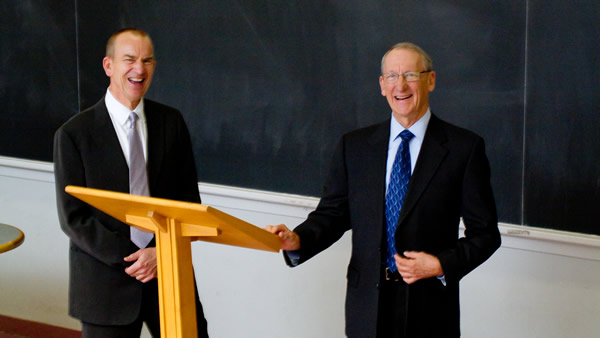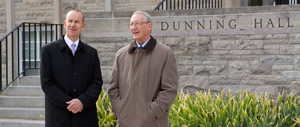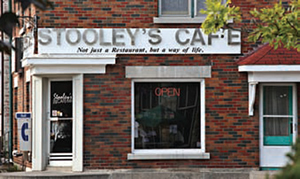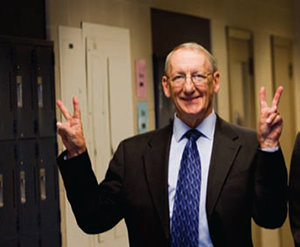The Bargaining Game

It may have been called a game, but it was serious business for generations of Queen’s business students from 1970 to 2003. The Bargaining Game was a required element of negotiation courses taught in both the Commerce and MBA programs. It was the brainchild of Bryan Downie, Professor of Industrial Relations, Negotiation and Dispute Resolution, at QSB from 1965 to 1999. For many students, it was a highlight of their Queen’s experience – a sheer adrenalin rush for the highly competitive, made all the sweeter when victory was claimed. For others, it will always be associated with the agony of crushing defeat and the indignity of being subjected to gloating by classmates. The stakes were high: $25 surrendered at the start of the game by each student, and 40% of the course mark – of which 20% was on the line the night the Bargaining Game took place.
 Bryan Downie It became legendary. Word spread from upper-classmates about their Bargaining Game experiences, so when the next crop of students approached the Game, they had an inkling of the drama that awaited them. But knowing and experiencing are two very different things.
Bryan Downie It became legendary. Word spread from upper-classmates about their Bargaining Game experiences, so when the next crop of students approached the Game, they had an inkling of the drama that awaited them. But knowing and experiencing are two very different things.
The concept was straightforward: to replicate the real-life pressure of a collective bargaining session. Student teams of five were divided into labour and management camps. A case outlined the issues of contention, from working conditions to wages, worker seniority to perks and benefits. Negotiations began at 6:00 p.m. when the various teams would take over meeting rooms and classrooms throughout Dunning, Mackintosh-Corry and, later, Goodes Hall. If no settlement was reached by 7:30, the labour team was to take its members out on strike. That's when the costs started to accumulate, including lost wages and benefits on the labour side; revenue and penalties for cancelled contracts on management’s side. Costs started off low but escalated – sometimes to the point where the costs of the strike outweighed the benefits of victory for either side.
Rick Jackson, MBA'71, and several classmates were among the first to be exposed to the Bargaining Game as volunteers, playing for pride, in 1970. Two years later, George Smith, BCom'73, and his classmates were among the first undergrad students to tackle the Bargaining Game as a required element of their negotiations course (Commerce 355).
George would go on to a distinguished career, recently retiring as Senior Vice President, Organization and Human Resources, at CBC/Radio-Canada. Rick returned to Queen's to teach at the School in 1974 and would become the recipient of numerous accolades, including recognition by the Commerce and Alma Mater Societies for both his teaching excellence and contribution to student life. Following in his mentor's footsteps, he assigned the Bargaining Game to students in his negotiations courses until 2003 and retired in 2008.
George and Rick were asked to reminisce about the Bargaining Game and graciously agreed to compile their recollections to share with QSB Magazine readers, many of whom are veterans of the Game.
– Editor
"We saw the same behaviours as those exposed in real-world collective bargaining: frustration, anger, walkouts, hidden agendas, breakdowns.”
George Smith: Bryan Downie was a true pioneer. The Bargaining Game arose from his imaginative way of tapping into the teaching power of experiential exercises.
Rick Jackson: While they're quite common in negotiations courses today, simulations were extremely rare 40 years ago. Courses at that time were mostly a series of formal lectures; even class discussions were new. Bryan's Bargaining Game may not have been the first such simulation offered at a Canadian university, but it was the one that most effectively replicated the pressure of real-world bargaining.
George: It was Bryan's simple but ingenious application of the concept that what drives parties in a dispute to compromise and settle is pressure, pure and simple – the pressure from the consequences of not settling.
 Rick: In the Bargaining Game, that pressure came in two forms: real money and marks. The $25 each student brought to the game was placed in a team pot. When the union went out on strike, both parties had to start paying strike costs from their team's pooled resources.
Rick: In the Bargaining Game, that pressure came in two forms: real money and marks. The $25 each student brought to the game was placed in a team pot. When the union went out on strike, both parties had to start paying strike costs from their team's pooled resources.
George: Marks were assigned on the basis of the relative value of the net settlements after strike costs incurred by both parties were factored into the settlements. As an added inducement, there was one other strictly enforced rule: 'No settlement' resulted in a mark of zero out of 20 and forfeiture of each student's $25.
Rick: Another 20 marks were assessed for a pre-game strategy report. This mitigated the effect of a mark of zero in the Game and also forced students to plan, prepare, and think strategically. The report also demonstrated how students planned to put into practice the bargaining theory they were learning in the course.
While the Game started at 6:00 p.m., agreements didn't usually begin to come in until 11:00 p.m., then continued into the wee hours of the morning. It wasn't uncommon to receive settlements at 3:00 a.m. It quickly became a matter of timing: using the power from the rapidly accelerating strike costs to force the other party to greater compromise, but coming to agreement before high costs rendered any deal a Pyrrhic victory* at best. (Ed. Note: A Pyrrhic victory is won at too great a cost to have been worthwhile for the victor. It refers to the victory by King Pyrrhus of ancient Greece, whose victory over the Romans caused extremely heavy Greek losses.)
George: If the strike costs were too high, a team might "beat" the other side, but the net value of their deal, compared to those of their classmates, would rank their team at the bottom of the class and result in the lowest mark. Like a very long strike in the real world, one party may "win" (in the sense of beating the other side) but, really, both sides lose. Unfortunately, I've seen that happen in real life more than once since leaving Queen's.
Rick: I remember volunteering as a first-year MBA student to participate in a simulation in 1970. Bryan and Professor (later Dean) of Law John Whyte organized the first game. It pitted four MBA teams against four Law teams. There were no marks involved; the pressure came from the spirit of competition, pride and the desire not to let down one's school.
George: Rick, stop talking like a professor. You just wanted to beat the law guys!
Rick: George, I won't dignify that comment with a response. (But you may be right.) Three of the MBA teams won their negotiations decisively; the fourth agreed to a compromise deal over beer in the student pub.
George: No doubt a reflection of your great bargaining skill.
Rick: As it turned out, our team did have some skilled negotiators and they went on to prove that in their professional lives. While the law students understandably framed collective bargaining as a legal process, we had the great advantage of understanding that it was a strategic, tactical, and decision-making process in which timing and a certain amount of risk-taking were vital. It made all the difference.
We learned another important lesson that day: the power of a credible final commitment. By coincidence, our end-of-year banquet was to start at 6:30, as I recall. We mentioned this to our law counterparts when negotiations started at noon. Our team was blessed with a truly gifted negotiator (not me), and around 5:30 he suggested we make a firm final offer. After intense debate, we decided – with some serious misgivings (from me) – to do just that. We politely explained that we had to leave for the festivities by 6:15 at the latest, and that this therefore had to be our final offer. The law students were outraged – "You can’t just walk out! That’s bargaining in bad faith!" Our spokesman explained that we had to leave and that this was indeed our final offer. They gave in, but they hated it.
George: My class (Commerce ’73) was one of the first to experience the bargaining game in the context of an actual course. Unlike subsequent classes, we had no war stories to help prepare us for the experience. We were young undergrads, used to being told what to do by professors. Here, though, there was no professor telling us what to do, no rule that we had to settle by a certain time (or at all), no book telling us how to do it, and no one to help. And $25 was a lot of money for students in those days. No one had ever 'lost' that much in a classroom before.
Unlike the MBAs and lawyers-to-be in your 'trial', Rick, this was a class of undergraduates who had little or no business experience. We were negotiating with peers – people with whom we'd experienced Frosh Week, people we sat next to in class and lived with in the Ghetto – and we found it hard to get into our roles as adversaries. But Bryan was a master teacher and role-player himself. He would really put on his game face for the evening. This usually accessible professor would become quite stern and intimidating, which invariably discouraged any student silly enough to ask for help.
One team’s "Final-Offer First" strategy backfired.
 Rick: In 1977, I was lucky enough to start teaching the Commerce 355 course with Bryan. The highlight was always the Bargaining Game, though I soon learned how much time and effort it required, now that I was on the other side of the lectern. It took four to five weeks to set up the Game and develop the students' understanding of the setting and context while simultaneously teaching bargaining theory.
Rick: In 1977, I was lucky enough to start teaching the Commerce 355 course with Bryan. The highlight was always the Bargaining Game, though I soon learned how much time and effort it required, now that I was on the other side of the lectern. It took four to five weeks to set up the Game and develop the students' understanding of the setting and context while simultaneously teaching bargaining theory.
The Game itself was logistically complex. There would typically be 10 to 12 sets of negotiations going on in different rooms on campus. It was a lot of work just to get students, materials and observers in place, on site. The observers were fourth-year students who were paid a stipend to keep tabs on how the teams were faring. A Chief Observer would circulate and report back to Bryan and me in our 'Action Central' office. Once the Game was well underway, we would go to Minos Restaurant downtown for a rushed dinner. We knew that our presence early in the evening was superfluous and we needed some sustenance to make it through the long night ahead. By "Bargaining Game Night," the students were really pumped up. One memorable Game night, when the clock struck six to start the game, one fellow leapt off a table so exuberantly that he launched himself into a low ceiling beam and spent the evening in Hotel Dieu Hospital's emergency room. What he really minded was missing the game.
Each Game night, we experienced a curious combination of feelings: excitement, relief, but also a strong sense of having just set a huge freight train in motion, downhill, with the resulting dread and a fervent hope that the thing wouldn’t go off the rails! Given the high stakes – marks, money, pride, relationships – the proverbial 'train wreck' was certainly not beyond the realm of possibility.
George: Despite the stresses, it was clear that Bryan enjoyed the game and learned from each one. He constantly added improvements so that it more closely resembled real-world negotiations, with all the associated pressures.
Rick: Yes, and because of the pressure, we saw the very same behaviours as those exposed in real-world collective bargaining: frustration, anger, walkouts, hidden agendas, breakdowns.
I vividly remember a team using a "Final-Offer First" strategy on their opponents quite early in the negotiations ("Call us at Stooley's when you’re ready to accept our offer").The call never came, and everyone on both sides got a zero! What a lesson in the power of anger to trump self-interest! The opposing team said afterwards, "We were so mad that we’d rather fail the course than give in to those people!" Several people did in fact fail the course that year.
As for the $25 collected from each student, each team’s pot was collected at the end of the evening and a strict accounting took place. Observers' stipends were deducted from the total, nominal cash prizes were awarded to the first-place union and management teams, with the rest of the proceeds refunded to the students on a per capita basis – except, of course, in the case of teams who forfeited their money if they didn’t settle.
Over the years, the Bargaining Game became part of the School’s folklore – a rite of passage of sorts for Commerce students.
George: Yes; people either loved it or hated it. The Game exposed the good, the bad and, sometimes, the ugly behaviour of the individuals involved. Bryan told me about a student who, after the Game concluded, didn't speak to anyone on either side until well after graduation. Then there was the MBA student in his mid-30s, a man with considerable real-world work experience, who told Bryan he had been expecting a 'Mickey Mouse' academic exercise and was absolutely amazed at how wrapped up in it he became, and how personally he took it.
 Rick: Most often, it was a very positive experience and, for many, a powerful one. Indeed, many students discovered something in themselves that subsequently influenced the direction of their careers. But sometimes a team would fall apart or have such a tough time with the other team that friendships and relationships would be affected. That was something that Bryan and I always worried about – one aspect of the proverbial train wreck that, fortunately, happened very rarely.
Rick: Most often, it was a very positive experience and, for many, a powerful one. Indeed, many students discovered something in themselves that subsequently influenced the direction of their careers. But sometimes a team would fall apart or have such a tough time with the other team that friendships and relationships would be affected. That was something that Bryan and I always worried about – one aspect of the proverbial train wreck that, fortunately, happened very rarely.
George: Bryan took some risks to give us an unforgettable learning experience.
Rick: Yes; many Commerce and a lot of MBA grads – not least you and me – owe him a debt of gratitude.
